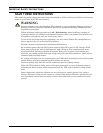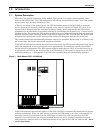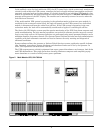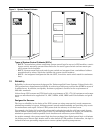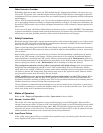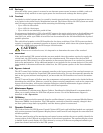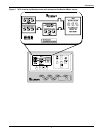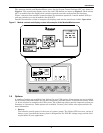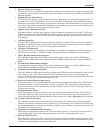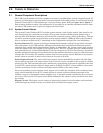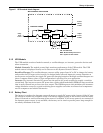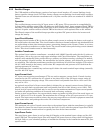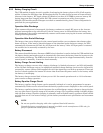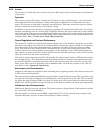
Introduction
9
2. Battery Racks or Cabinets
The battery racks are specifically designed for stationary service batteries. They are painted with
electrolyte-resistant paint for corrosion resistance. Battery cabinets are available for 150 through
600kVA modules.
3. Module Battery Disconnect
The UPS system utilizes a separate Module Battery Disconnect for remotely located batteries. A
sensing circuit in the UPS module, set at the battery low voltage limit, trips the Module Battery
Disconnect to safeguard the battery from excessive discharge. The Module Battery Disconnect has
an undervoltage release mechanism designed to ensure that during any shutdown or failure mode
all battery potential is removed from the UPS system.
4. Input Current Distortion Filter
This filter reduces rectifier input current reflected harmonic distortion to less than 7% reflected
THD and less than 4% reflected THD for modules with the optional 12-pulse rectifier. The filter is
factory installed within the UPS. This filter also improves the input power factor to better than
0.92 lagging.
5. 12-Pulse Rectifier
All 500-750kVA models may be ordered with the optional 12-pulse rectifier section; this feature is
standard in 1000kVA models. This provides input isolation and reduces input current reflected
THD to less than 9% or less than 4% with optional input filter.
6. Isolation Transformers
An optional rectifier input isolation transformer is available in a matching transformer cabinet;
this feature is standard in 1000kVA models. A bypass isolation transformer is also available.
7. Three Breaker Maintenance Bypass
This switchboard provides make-before-break maintenance bypass. It includes: UPS Bypass
Input Breaker (BIB), Maintenance Bypass Breaker (MBB) and Maintenance Isolation Breaker
(MIB).
8. Two Breaker Maintenance Bypass
This switchboard provides make-before-break maintenance bypass. It includes: Maintenance
Bypass Breaker (MBB) and Maintenance Isolation Breaker (MIB).
9. Load Bus Synchronization (LBS)
The Load Bus Sync (LBS) option keeps two independent UPS systems (and therefore their critical
load buses) in sync, even when the modules are operating on batteries or asynchronous AC
sources. This means that critical loads connected to both load buses through a Static Bus Transfer
Switch can be switched seamlessly between the two.
10. SiteScan Central Monitoring System
Liebert manufactures a central monitoring system that automatically displays key UPS measure-
ments and alarms, as well as data from a variety of sensors. This monitoring system activates
alarms so corrective action can be taken. Events and data can be printed in hard copy. Data can
be logged for analysis.
11. Remote Monitor Panel
The UPS system may also be provided with an optional Remote Monitor Panel. This Panel pro-
vides eight LED indicators and may be placed at a convenient location near the critical load. A
functional description of the Remote Monitor Panel is provided in 3.0 - Operation of this manual.
12. Customer Alarm Interface
This optional interface board allows the input and display of 8 alarms from customer-supplied
contacts, each with a customer-selected name of up to 16 characters. The following attributes can
be user programmed for each alarm: latching, summary, freeze history, sound horn, auto-dial and
time delay (0 to 999.9 seconds).
13. Temperature-Compensated Charging
When battery temperature climbs above a preset limit (typically 77 degrees F), this optional cir-
cuit proportionally reduces float charging voltage to prevent overcharging the battery.
14. Battery Load Testing
When activated, this option forces the battery string to assume the load for a short period of time.
The UPS then compares the test results to data collected during the UPS commissioning to see if
the battery system appears to meet specifications.



